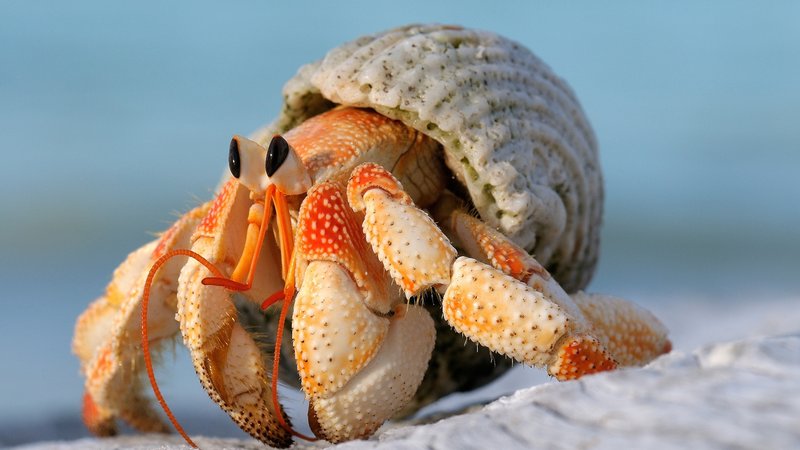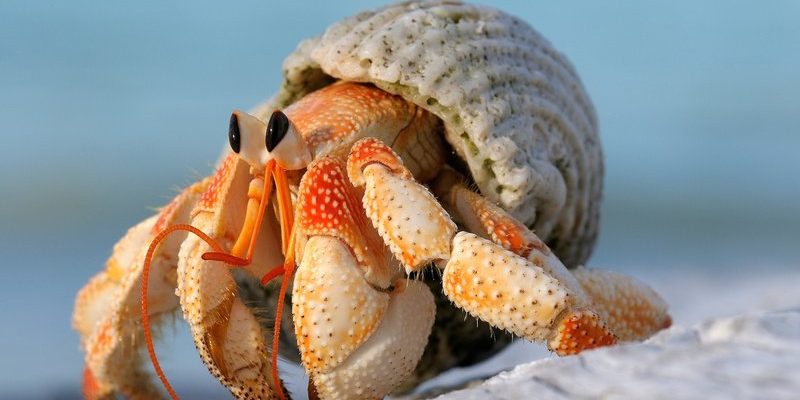
Hermit crabs are known for their unique habit of borrowing shells from other sea creatures. This quirky adaptation not only protects them but also gives them an important role in marine environments. If you’ve ever seen a hermit crab scuttling along the beach or in tide pools, you might have noticed their small size and playful personality. But, honestly, there’s so much more to them! Let’s dive deeper into the world of hermit crabs and understand the key roles they play in maintaining the balance of marine ecosystems.
What Are Hermit Crabs?
Hermit crabs belong to the family Coenobitidae and are not true crabs, despite their name. They have a soft abdomen that needs protection, which is why they seek out empty shells from other marine animals, like snails. Imagine moving into a cozy new apartment—this is what hermit crabs do, but they’re always on the hunt for better digs!
These creatures come in various species and sizes, ranging from the tiny, brightly colored Caribbean hermit crab to the larger, more challenging coconut crab. Each species has its unique quirks and traits, making them a diverse group within the marine world.
One interesting fact is that hermit crabs can live quite a long time—some even reaching 30 years in captivity! This long lifespan means they can build a significant presence in their habitats, providing that their needs for food and shelter are met.
The Role of Hermit Crabs in the Food Chain
Like many other sea creatures, hermit crabs play a crucial role in the food chain. They primarily feed on algae, dead fish, and decaying plant matter, acting as scavengers. By doing so, they help in breaking down waste and recycling nutrients back into the ecosystem, which is vital for the health of coral reefs and other marine environments.
You might be wondering how this scavenging benefits larger marine animals. Well, hermit crabs themselves serve as a food source for a variety of predators, including fish, birds, and even some larger crabs. This means they are not just cleaning up the ocean but also providing nourishment for others. It’s a classic “you scratch my back, I’ll scratch yours” situation in the natural world!
In this way, hermit crabs help maintain the balance of marine ecosystems. Their role as both consumers and prey keeps the cycle of life moving along smoothly.
Habitat and Shelter: The Importance of Shells
As mentioned before, hermit crabs are famous for using shells as their homes. This habit is not just a quirky trait; it’s essential for their survival. The shells provide protection from predators and harsh environmental conditions. In a way, you can think of the shells as a hermit crab’s personal fortress.
When hermit crabs grow, they often need to find larger shells. This behavior can create competition among crabs, leading to a fascinating phenomenon called “shell exchange.” If two hermit crabs find themselves in a pinch, they may engage in a shell swapping ritual, which can be quite a sight! It’s like a tiny marketplace where the best shells are up for grabs.
The decline of shell availability due to human activities, like pollution and overharvesting, poses a threat to hermit crab populations. Protecting their habitats and ensuring they have access to shells is crucial for maintaining healthy marine ecosystems.
Hermit Crabs and Coral Reefs
Coral reefs are often referred to as the “rainforests of the sea” due to their incredible biodiversity. Hermit crabs contribute to the health of these ecosystems in several ways. By consuming detritus, they help keep the reef clean and reduce harmful algae growth, which can smother corals.
In addition to cleaning, hermit crabs help aerate the substrate where corals grow. As they burrow and scuttle about, they create spaces in the sand and sediment, allowing better water flow and oxygenation. This improved environment can promote coral growth, making it a win-win for both species!
So, next time you think of coral reefs, remember that hermit crabs play a silent, yet essential role in sustaining those vibrant underwater gardens. Their presence indicates a healthy, thriving ecosystem, showing just how interconnected life in the ocean truly is.
The Impact of Human Activity on Hermit Crabs
Unfortunately, human activity has a significant effect on hermit crabs and their habitats. Pollution, climate change, and habitat destruction all pose serious threats to these tiny creatures. For instance, plastic waste can lead to shell shortages since hermit crabs may mistakenly use debris as homes, which can be harmful.
Additionally, overfishing can decrease the availability of shells. Many people collect shells for decoration or souvenirs, not realizing that they disrupt the delicate balance of marine life. It’s important to consider the needs of hermit crabs and other marine wildlife when engaging with coastal environments.
If we want to protect hermit crabs and the ecosystems they support, we must advocate for responsible practices. Supporting conservation efforts, reducing plastic use, and respecting marine life can go a long way in preserving these essential creatures.
How to Keep Hermit Crabs as Pets
If you’re intrigued by hermit crabs and want to bring the ocean a little closer to home, keeping them as pets can be a rewarding experience! However, there are some key points to consider to ensure they thrive in your care.
First, it’s crucial to provide a suitable habitat. A spacious aquarium with a secure lid is ideal, along with plenty of substrate for burrowing. You’ll also need to offer several shells of various sizes for them to choose from—like a shopping mall for crabs!
Hermit crabs require a balanced diet, so be sure to feed them a mix of commercial crab food, fruits, and vegetables. Regularly misting the enclosure will help maintain humidity levels, which is important for their well-being.
Lastly, social creatures by nature, hermit crabs do best in small groups. Just make sure to monitor them closely for any signs of aggression, as they can sometimes get territorial. With the right care, these little critters can be wonderful companions, allowing you to enjoy the fascinating life of hermit crabs up close.
Hermit crabs might be small, but their impact on marine ecosystems is anything but insignificant. From their role in the food chain to their contributions to the health of coral reefs, these little creatures play vital roles in maintaining the balance of life underwater.
As we become more aware of the challenges they face due to human activity, it’s essential we take steps to protect their habitats and promote responsible interaction with marine environments. Whether you’re watching hermit crabs play in tide pools or keeping them as pets, we can all appreciate their quirky nature and vital contributions.
By valuing these tiny heroes of the sea, we can ensure they continue to thrive and enhance the incredible diversity of our oceans for generations to come.

